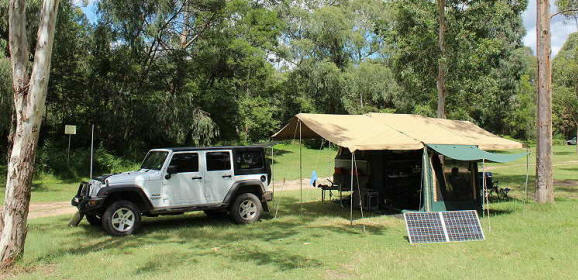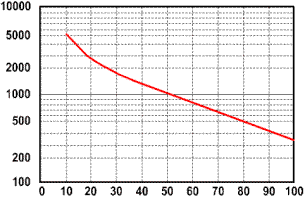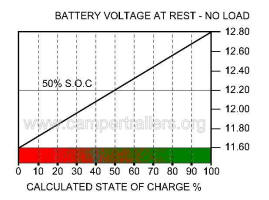|
12volt
system
to
suit your own needs

One question
that crops up from members in the Australian CamperTrailers Yahoo Group, Forum & Facebook
Group relates to what is needed in setting up a 12volt battery system in a camper
trailer, the type of battery to use, the size of battery & the size
of the solar panel.
Most will start with a deep
cycle battery & a 240volt multistage charger to maintain the battery at home
between trips, then add a solar panel to charge the battery in camp & perhaps a DC to DC charger
for touring holidays at a later stage. It is a good idea to have
your final set up in mind which will save you money in the long run.
I hope this article gives a little
insight in helping to set up a 12volt system to suit your
own needs without being too technical.
batteries
A deep cycle battery, preferably an
AGM or absorbed glass matt, is the best battery type suited for camping.
These batteries can be discharged more deeply & recharged more
readily
than a starter battery used in a car.
As you can
see on the graph below left, discharging only 10% of the battery capacity
may give you 5000 cycles, compared to discharging to 90% which may give you only 400 cycles.
Checking your camper trailers deep cycle battery
for state of charge while it is charging using a voltmeter will not
show its true state of charge as all you are reading is the
surface charge.
You need to allow the battery to 'rest' for at least a couple of
hours, preferably eight, for the surface charge to dissipate. It is
like filling a glass with Coke & looking as if it is full, when in
fact the top is froth. You need to let the fizz settle to see how
much is really in the glass. The state of charge does not measure
the storage capacity, performance level or the health of a battery.
 |
 |
| depth of discharge v's
number times recharge |
percentage to voltage at
rest |
battery
size
A basic 12volt battery system can
be a portable AGM battery in a battery box to cover your power needs over a
weekend.
So lets say if your compressor fridge run as a fridge
uses 20 amp-hours over a 24 hour period & you are camping for two
days, you will use 40 amp hours in that time. Add to that a couple
of hours running LED lighting, four hours at 0.5 amps, that would be 2 amp-hours. Total power needs over a two day weekend equals 42 amp-hours. Therefore a 100 amp-hour battery
would be suitable.
appliances &
accessories
The most common appliances & accessories people use while camping is
a 12volt compressor fridge such as an Engel or Waeco
etc, recharge mobile phone, laptop or camera batteries, perhaps
running a Cpap machine & LED lighting at night.
It is hard calculating the power
usage of a compressor fridge as there are so many factors involved
such as the fridges size, the rated power consumption of the
motor, the ambient temperature, where the fridge is placed, how many
items at ambient temperature is placed in the fridge, the fridges preset temperature, to name a few.
The fridge will not
run all the time, but runs & then turns off or cycles to keep the preset
temperature. By using a Watts Up Meter I was
able to see exactly what the
draw of our
40 litre Engel fridge when run as a fridge, while
the graph in Jeff's article will let you see how it all works
maintaining his 35 litre Engel's internal temperature.
battery charging
at home
After running the fridge from a
suitably sized
deep cycle battery over the weekend & keeping the battery capacity above
50%, you will need to recharge
the battery at home to maintain it in a state of good health. A 240volt multistage charger
that is designed to charge an AMG battery is the most suitable. These chargers usually have three or more modes
in the charging process, ie bulk, absorption & float to fully
charge the battery.
It is recommended a 240 volt multistage charger
of around 10% to 15% of the battery capacity be used, that is a 10
to 15 amp charger is suitable to charge a 100 amp-hour deep cycle
battery. A smaller size charger will take longer to do the job, but
will not
knock the sulphate off the plates.
If you are looking at adding another battery
sometime in the future, you will save money by buying a charger to
suit your intended battery capacity from the start.
solar
in camp
A solar panel is the most
convenient way to
charge the battery when camped. The size of the panel will be
governed by your power usage & the availability of the sun depending
on the time of year. It is best to size your solar panel
so the battery is fully charged just after lunch.
A typical solar panel will have an output of
around 18 volts which is way too high to charge a
battery. A solar regulator is needed to regulate the power going
from the solar panels to the battery. Overcharging will significantly reduce
battery life & at worst damage the batteries to the point where they
are unusable.
A portable solar panel kit has a solar regulator on the back of the panel. There are two
different types of solar regulators used, a PWM & a MPPT.
PWM or Pulse Width Modulation slowly lowers the
amount of power applied to the battery as the battery get closer to
fully charged.
MPPT or Maximum Power Point Tracking regulators are able to convert
excess voltage into amperage by calculating the output from
solar panels to provide the maximum current possible at the required
voltage at any given point. During low light level situations the
MPPT will compensate for the low light level & find the new point at
which the solar cell delivers its maximum power output.
calculating a
system
So how do you go about sorting
everything to make a 12volt system to suit your needs.
Redarc have an easy to use 12volt
system calculator
http://www.redarc.com.au/solar
Richard's Solar Spreadsheet is a
more accurate way to see what size battery & solar panel you require
by calculating the power usage of various appliances & accessories
you wish to use at different locations & times of the year
http://www.campertrailers.org/solar_spreadsheet.htm
If you run the fridge as a fridge
you could offer a rough average power consumption per day to the
spreadsheet by entering one-third of the rated amps. This figure can be
found printed on the back of the fridge in A or amps as 'rated DC
current' or 'DC power consumption'. If the fridge is rated at 4.5 amps
then over an hour with the motor running 33% of the time, the power
consumption would be 1.5 amp-hours.
This is the power draw of our 40 litre Engel
http://www.campertrailers.org/fridge_draw.htm
On the spreadsheet info page you
will also find a table for Peak Solar Sun Hours
which will allow you to see how a solar panel will charge the battery for a
select location & month. You can also throw in an overcast day with
little or no solar input & see how the battery recovers.
expanding
Voltage drop is the biggest downfall in charging
a remotely located battery in a camper trailer which is a long way
from the vehicles alternator, sometimes around ten metres or more.
Recent advancements in battery charging technology such as DC to DC
chargers, now sees batteries charged to 100% capacity while driving.
This gives extra battery capacity when stopping for a few days at a
time in different campsites on a touring holiday, rather than having
to chase the sun with a solar panel on arrival after a day on the
road.
further reading
Bill Darden battery facts
http://www.batteryfaq.org
Collyn Rivers articles
http://caravanandmotorhomebooks.com/articles-index
Smart Gauge
http://www.smartgauge.co.uk/technical1.html
wiring diagrams
http://www.campertrailers.org/jamies_12volt_wiring_diagrams.htm
voltage drop calculator
http://www.redarc.com.au/handy-hints/calculator/voltage_drop_calculator
cable conversion chart
http://www.campertrailers.org/collyns_page.htm#Conversion
cable size calculator
http://www.redarc.com.au/handy-hints/calculator/cable_size_calculator
Redarc BCDC1225 install
http://www.campertrailers.org/bcdc1225_install.htm
Redarc BCDC1225 feedback
http://www.campertrailers.org/bcdc1225_feedback.htm
Enerdrive battery monitor
http://www.campertrailers.org/enerdrive_elite.htm
watts up meter
http://www.campertrailers.org/watts_up_meter.htm
35 litre Engel fridge draw
http://www.campertrailers.org/fridge_power_consumption.htm
40 litre Engel fridge draw
http://www.campertrailers.org/fridge_draw.htm
by Rob Sanderson
december 2015
|